Curious about the major landmarks in Brazil? In today’s article, I’ll talk about the top attractions that will blow your mind.
As a Brazilian, I know my country has plenty of colonial towns, untouched beaches, and beautiful nature.
But what are the main landmarks and attractions in Brazil?
Several readers have been asking me this question in the last weeks. That’s why I decided to write not only about the famous places in my country but also about some offbeat ones you might not know they exist.
Before meeting me, my Dutch husband only knew about six of the places I’ll talk about below.
And as you can imagine, most of those monuments and landmarks are in Rio de Janeiro.
The city is indeed beautiful, but the country has much more to offer. I guarantee.
So, wanna learn some new information about landmarks in Brazil? Read on!
Not enough time to read this article in one sitting? Then save it for later!
21 Landmarks in Brazil
It was quite challenging to narrow down the top Brazilian landmarks because the country is massive.
Still, in this article, I talk about not only famous structures in Brazil but also some offbeat constructions in hidden corners of the country.
Either way, they will blow your mind.
Christ the Redeemer Statue
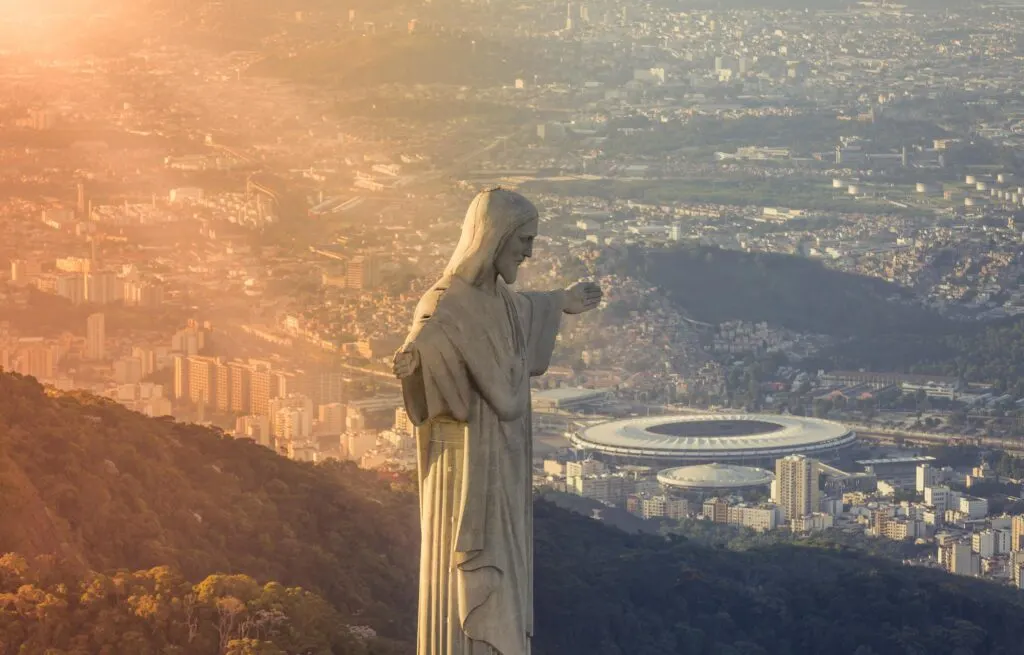
Christ the Redeemer is one of the most remarkable Brazil landmarks, which also happens to be the biggest and most famous Art Déco statue in the world.
Standing atop Corcovado (which means ‘hunchback’), Cristo Redentor gazes out over Rio, a placid expression on his well-crafted face.
It took four years to build the pieces in France and ship them to Brazil, and then it took five more years of hard work to mount it before its inauguration in 1931. Today, it stands at 2,300ft (700m) above sea level.
In 2007, the sculpture was elected one of the Seven Wonders of the World, and rightly so because it welcomes tourists with wide open arms and blesses Cariocas, Rio de Janeiro natives.
Through donations mostly from the Catholic church, the “Statue of Christ” was commissioned to Brazilian engineer Heitor da Silva Costa and French sculptor Paul Landowski.
Nowadays, thousands of triangular soapstone tiles form a mosaic that covers this Brazilian landmark. It’s arguably the country’s symbol.
Amazon Theater
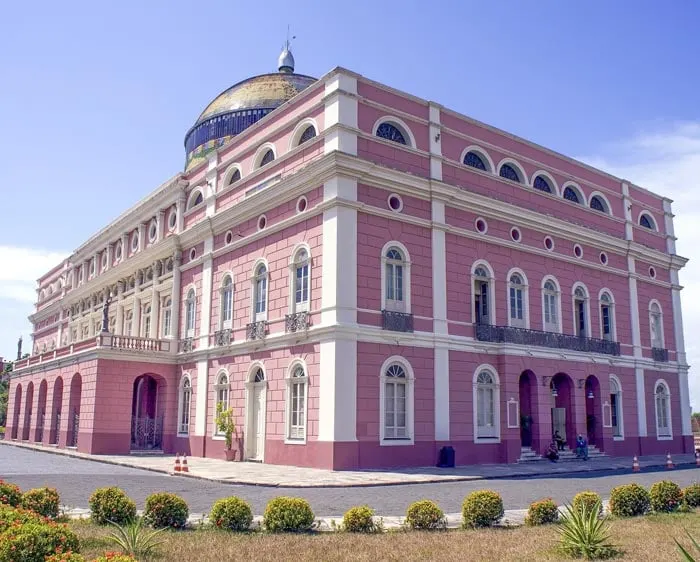
Teatro Amazonas is a charming opera house in Manaus, right in the heart of the Amazon Rainforest.
It was chosen by Vogue magazine as one of the most beautiful ones in the world.
The theater is the state’s leading cultural and architectural symbol because it keeps alive much of the history of the rubber cycle, the golden age of the Amazonian capital.
Inaugurated on December 31, 1896, the theater is imposing and massive.
Later in 1966, it was listed as a National Historic Landmark.
The concert hall has a capacity of 701 people, distributed between the audience and three cabin floors.
It’s impossible not to be mesmerized by the concave ceiling, which features four paintings made in Paris.
Outside, the famous dome draws attention for its exuberance. This part is composed of 36,000 ceramic pieces in the colors of the Brazilian flag, imported from Alsace, France.
In case you’re planning your visit, know that the theater’s performance schedule includes a great opera festival in April and May.
Cathedral of Brasília
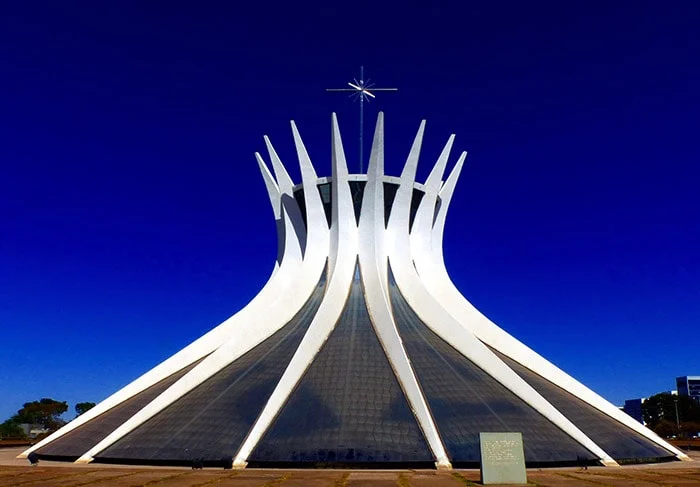
The first monument created in the country’s capital, Brasilia, was the Metropolitan Cathedral designed by the architect Oscar Niemeyer.
Both the interior and exterior of the church are considered a work of art. Thanks to this project, Niemeyer received the top architecture prize, Pritzker, in 1988.
Following his modernist style, the building has sixteen concrete columns that converge in a central circle.
The patron saint of Brasilia (and consequently the Cathedral) is Our Lady Aparecida, also the patron saint of Brazil.
Here you’ll find a replica of the saint; however, the original is in Aparecida’s Basilica in São Paulo.
The highlights of the Cathedral of Brasilia are the pond surrounding the church, which only allows you to enter it by an underground passage, and the stained-glass windows that are 6,562ft (2.000m) long.
Take a sneak peek inside to visit not only a church but also a museum. The interior of this religious construction brings together a series of exquisite works of art of Brazilian and international artists. Pope Paul VI donated the altar to the church.
Lençóis Maranhenses
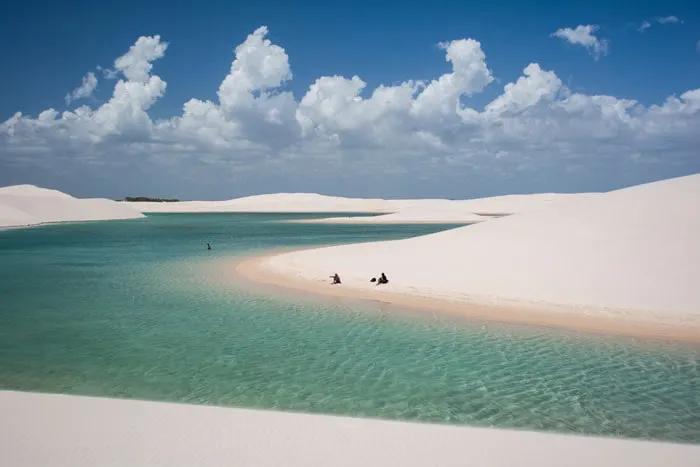
The Lençóis Maranhenses, one of the most famous landmarks in Brazil, are mesmerizing.
This 598sq mi (1.550sq km) national park is covered in expanses of sand dunes, which look like undulating bedsheets (Portuguese: lençóis) going as far as the eye can see.
But the highlights of this spectacular place are the crystal-clear lakes and pools between the dunes.
They’re created during the rainy season May-Sep, so be sure to plan your trip around June, July, and August, when they are at their best.
Although the lagoons are exceptional, you’ll also find beaches in the park.
Botanical gardens in Curitiba
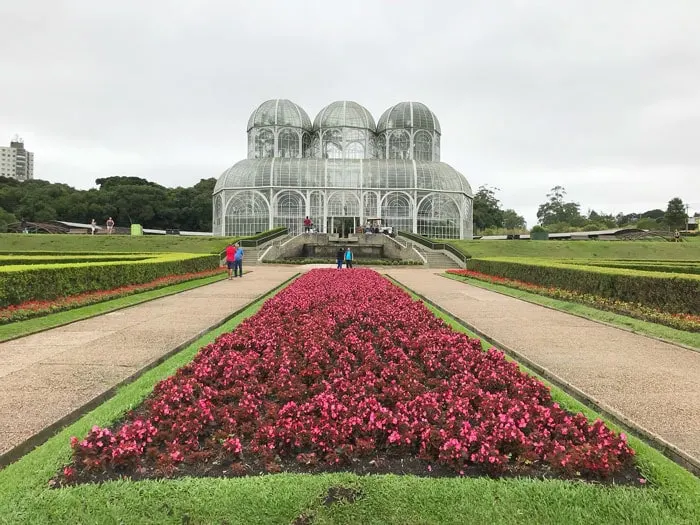
In 1991, the Botanical Gardens opened its doors for the first time to become one of the most visited sights of Curitiba.
The gardens were created in the style of French gardens, and besides a carpet of flowers rolled out at the entrance, it also houses a 3-domed tropical glasshouse.
This metallic structure houses botanical species that are a national reference, as well as a little fountain.
It’s a laid-back place to relax and stroll on a beautiful day and a must-visit in Brazil.
Copacabana Beach
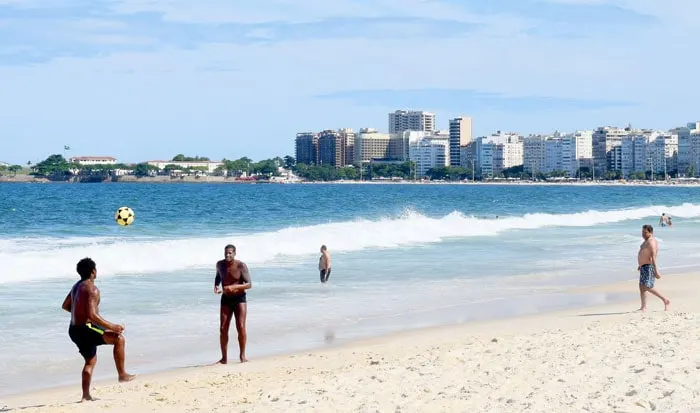
The undulating black and white pattern of the promenade at Copacabana is unmistakable.
Rio de Janeiro’s most famous beach is also one of the major Brazilian landmarks.
Any visit to the Marvelous City (aka RJ), must also have a stop by this lively area.
Sunbathe in the Brazilian style, play soccer on the beach, drink a cold caipirinha, swim to recharge your energies.
Whatever you do, just remember Rio de Janeiro beaches are the best places to be on a sunny day.
São Paulo Cathedral
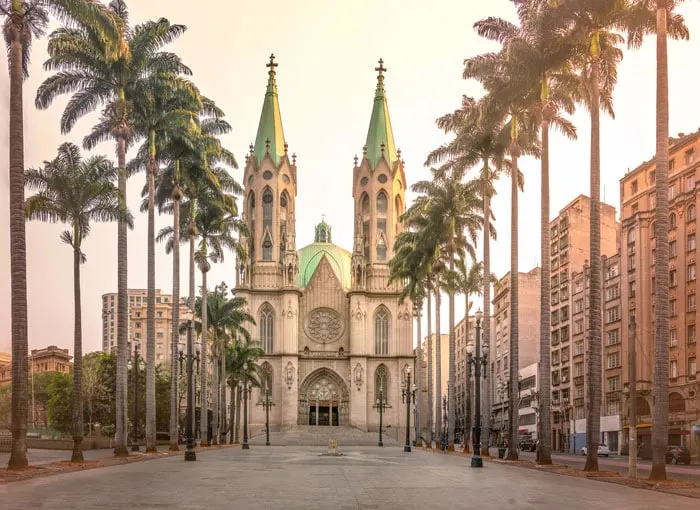
The Metropolitan Cathedral of São Paulo, also known as Sé Cathedral, was one of the first churches built in the city.
Today, it is considered one of the world’s most massive neo-Gothic monuments.
While the church is pretty huge, its pipe organ is Latin America’s largest one, with 12,000 pipes.
Its sizeable green dome was inspired by Santa Maria del Fiore, Florence Cathedral.
The stained glass windows portray biblical passages and even historical facts, such as the arrival of the Portuguese in Brazil.
Under the main altar, you can find the crypt, where several influential people from the history of São Paulo, but also from Brazil, are buried.
Chief Tibiriçá is one of them. He was the first Indigenous person of Brazil to be converted and baptized by the Jesuits José de Anchieta and Leonardo Nunes.
He was an ally of the Portuguese and had an essential role in the founding of the city.
Chapada dos Veadeiros
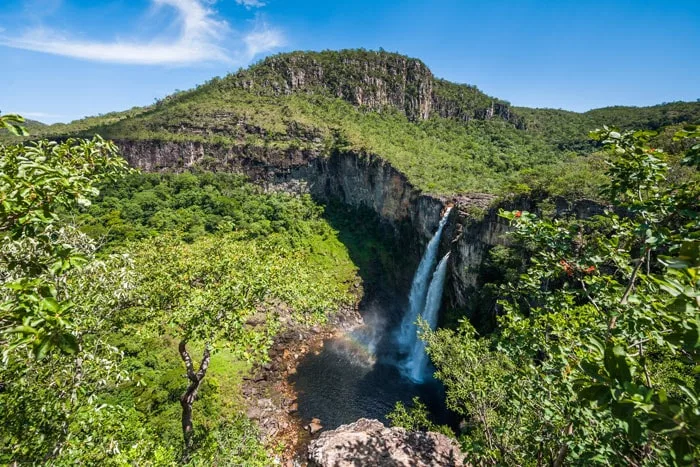
The Chapada dos Veadeiros is a national park on a high plateau with billion-year-old rocks.
Known for its fantastic fauna, flora, and geological formations, the park is massive.
As an area of protection of the Brazilian savanna, the cerrado, UNESCO listed it as a World Heritage Site.
If you are looking for adventure and want to connect with the natural wealth of Brazil, be sure to head over to the Chapada dos Veadeiros. It’s totally worth it.
Meeting of the Waters
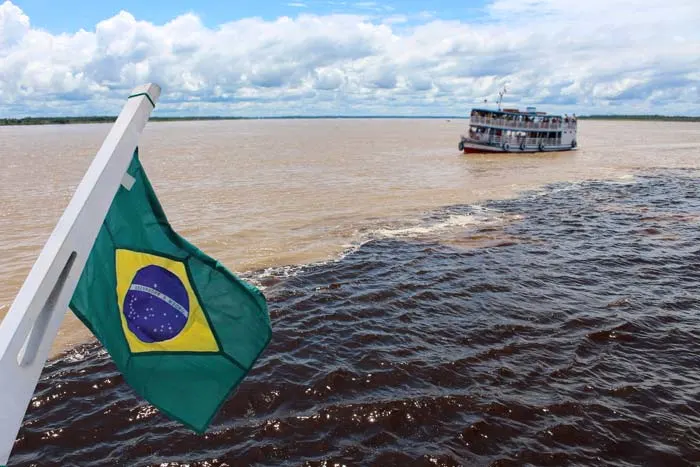
The Meeting of the Waters is a unique place in Brazil, let alone in the world.
That’s because here’s the confluence between the pale-brown Amazon and the dark Negro rivers.
These rivers flow at a different speed; therefore, one is colder than the other. That, together with their differences in density, is the reason they don’t mix but flow together for miles and miles.
To get here, take a boat tour from Manaus and prepare to gaze in awe at this wonder of nature.
Niterói Contemporary Art Museum
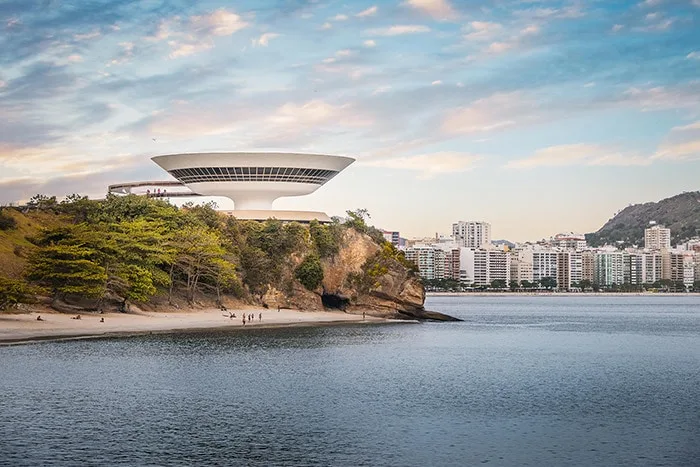
This museum is another artwork of Niemeyer, a Brazilian architect.
Completed in 1996, the museum has an iconic flower shape building overlooking the Guanabara Bay and Rio de Janeiro.
As if the building alone wasn’t enough, its collection has works of art of many Brazilian artists worth seeing, including Tomie Ohtake.
Most of the artworks date from the 1950s to the early 1990s.
While there, try to spot the Sugarloaf and Christ The Redeemer Statue.
Pelourinho
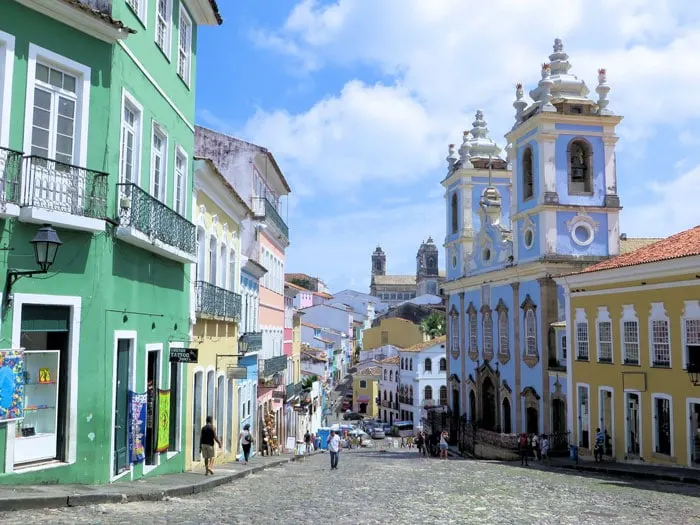
The neighborhood Pelourinho in the Historic Center of Salvador, Bahia, is one of the most colorful places in Brazil.
While the area is full of life nowadays, it wasn’t always this lively. Between the 16th and 19th-century, the Pelourinho (English: Pillory) was the center of the city, and the baroque style houses were built by African and Indigenous slaves.
At that time, the pillory was located away from the city. However, some planters decided to build one of those structures right in the middle of the main square to show their power and strength.
“Pillory” is the name given to the place where slaves were punished by the planters.
Due to this fact, the Pelourinho became a reference point of the city, giving its name to the old city center.
Today, the square is filled with colorful baroque houses, open-air bars, shops, and a lot of music. But its past has never been forgotten.
Selarón Steps
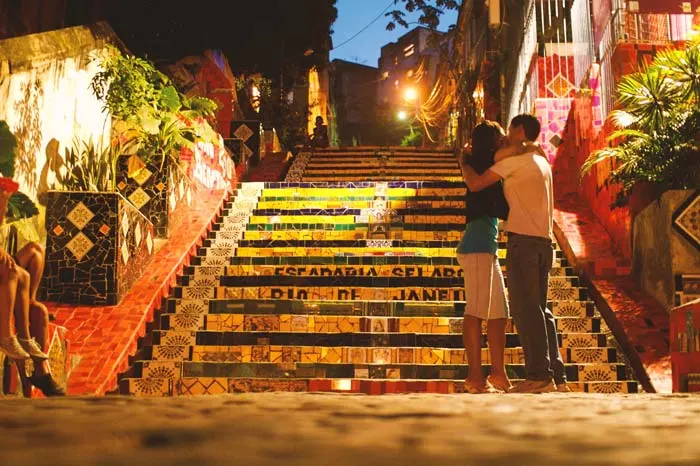
A Chilean artist, Jorge Selarón, created the world’s most famous and colorful steps in Rio de Janeiro. He claimed the 215 mosaic steps were a tribute to the Brazilian people.
The artist lived in one of the houses along the stairs and decided it was about time those steps were renovated.
Connecting Lapa to Santa Tereza, the Selarón Steps are covered in over 2,000 tiles collected from over 60 countries around the world.
While traveling in Rio de Janeiro, be sure not to miss this artist’s work of art. Stroll around and take a few photos on it. Although often crowded, it’s a beautiful place.
Fun fact: The steps were featured in Snoop Dogg’s “Beautiful” music video.
Bonito
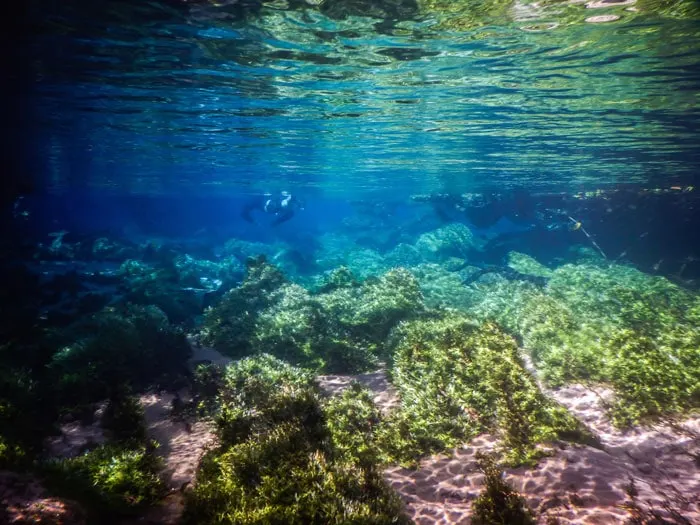
Bonito is an eco-tourism hub in central-west Brazil. Magical caves, mesmerizing waterfalls, and clear rivers are some of the natural tourist attractions in Bonito.
The region is a famous landmark in Brazil, mostly because of the pristine nature found here.
As a popular snorkeling location, Bonito is the perfect place to spot wild Brazilian animals in their natural habitat.
For instance, go snorkeling at River Sucuri around wintertime in the southern hemisphere (June/July).
Around this time, sucuri snakes leave their nest and see some sunlight in the clear water of River Sucuri. And in case you don’t know, sucuri is the so-called anaconda.
But don’t worry. Just hire a guide who knows the area, respects nature, and you won’t have to worry about a thing.
Paraty
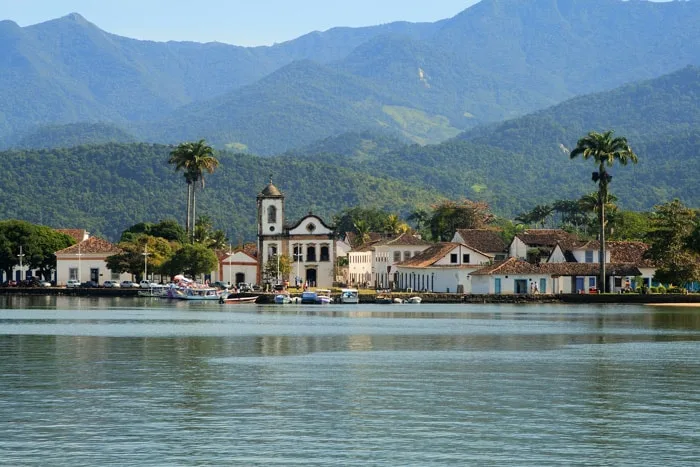
Pastel and whitewashed houses, cobblestone streets, and jungled mountains in the background, Paraty is a well-preserved colonial town and one of the most significant historical landmarks in Brazil.
This historic coastal town is the perfect mix of a cultural hub and natural landscape, and together with Ilha Grande, the town is considered a UNESCO World Heritage Site.
But Paraty has more than historic buildings and churches, the port town is also surrounded by beaches, spots to practice water sports, and some of the best waterfalls in Brazil.
Around July-August, Paraty houses Flip, the International Literary Party of Paraty. The festival brings together great names of literature in shows, exhibitions, workshops, and film screenings.
Another festival worth visiting is the Cachaça Festival, where you can taste our sugarcane-liquor, the national spirit. It happens in August.
Ibirapuera park
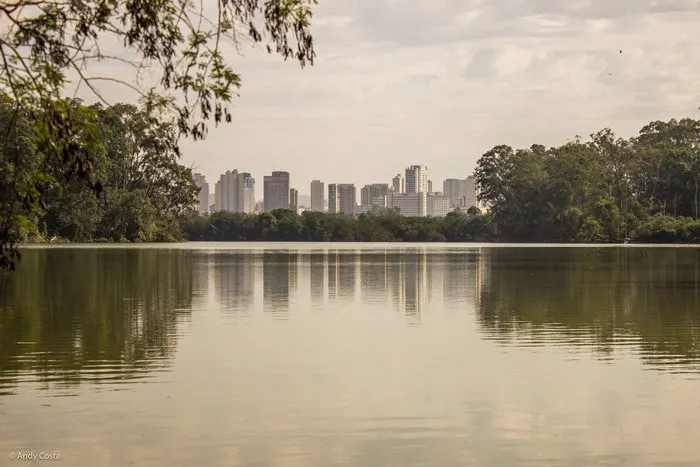
Latin America’s largest park is one of the major landmarks in Brazil. This much-loved oasis is where locals flock to escape the grayness of the town. Ibirapuera is an urban park among the skyscrapers in São Paulo.
But Ibirapuera is far from being only a park. The area boasts the Afro-Brazilian Museum, the Modern Art Museum, a Japanese Garden, a planetarium, a few restaurants, an auditorium, an exhibition space, and a few important monuments of Brazilian history.
Visiting Ibirapuera is not just going for a usual stroll at the park. It’s a sensory overload experience where you disconnect from the world and connect with nature and culture.
The area is one of the best places to stay in São Paulo and definitely a must-visit for anyone in town.
Ouro Preto
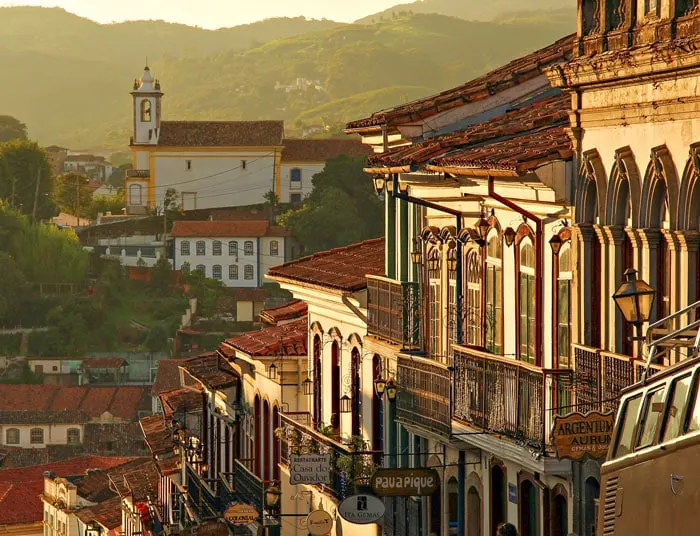
Ouro Preto is a sweet colonial town in Minas Gerais, best known for its baroque architecture.
With a small-town atmosphere, Ouro Preto is filled with churches, chapels, and museums, but also with history. With Brazilian history.
The city was formerly called Vila Rica (English: Rich Village) because of its abundance of gold. Still, after Brazil’s independence, it became Ouro Preto (English: Black Gold).
This name comes from the dark gold coated with an iron oxide layer found in the city.
Octávio Frias de Oliveira Bridge
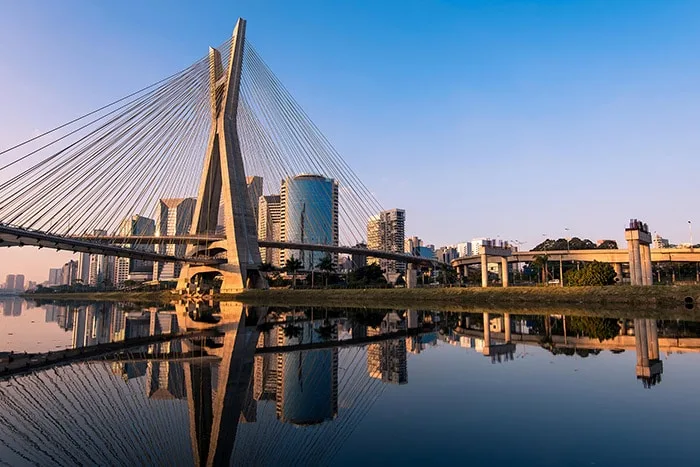
This cable-stayed bridge, also known as Ponte Estaiada, connects both sides of River Pinheiros in São Paulo.
The structure is 453ft (138m) tall, and because of its unique setting, this beautiful landmark in Brazil has become the city’s postcard.
Among skyscrapers and traffic jams, the bridge is an excellent landmark for urban photography lovers as the whole scene flows perfectly together.
From all the places I mentioned in this article, the Octávio Frias de Oliveira Bridge is by far one of the most offbeat landmarks in brazil.
Tip from a local: For the perfect picture, stay at the Grand Hyatt Hotel and ask for a room on higher floors with a view of the bridge.
Fernando de Noronha
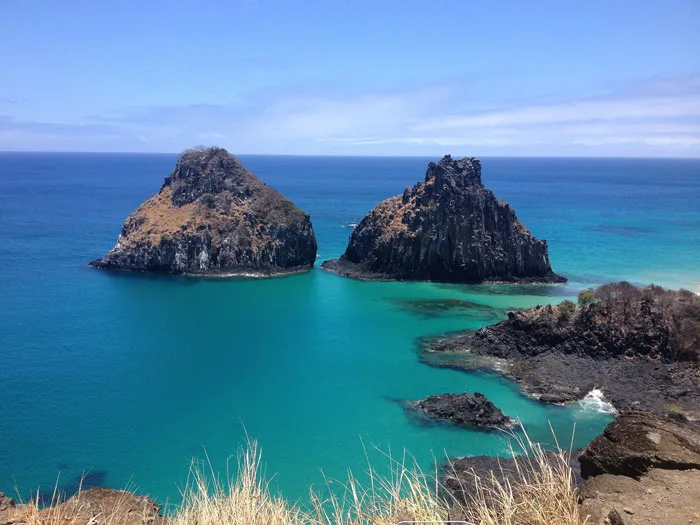
Brazil’s paradise, Fernando de Noronha is a volcanic archipelago off the coast of Pernambuco.
The islands are a protected marine national park and ecological sanctuary that is a famous place to spot animals in their natural habitat.
Sharks, dolphins, sea turtles, and rays are some of the species you can see in Fernando de Noronha.
While snorkeling and scuba diving are popular in the area, a considerable daily fee tries to decrease the mass of tourists visiting it.
That’s because this paradise is threatened with extinction.
The Brazilian government is doing little to control how many people get into the island and to control if those people even respect the rules while in Fernando de Noronha. And that’s causing an imbalance in the local ecosystem of this major landmark in Brazil.
Things like taking “souvenirs” back home, fishing, noise pollution, waste, and the construction of new hotels only contribute to the whole problem.
Museum of Art of São Paulo – MASP
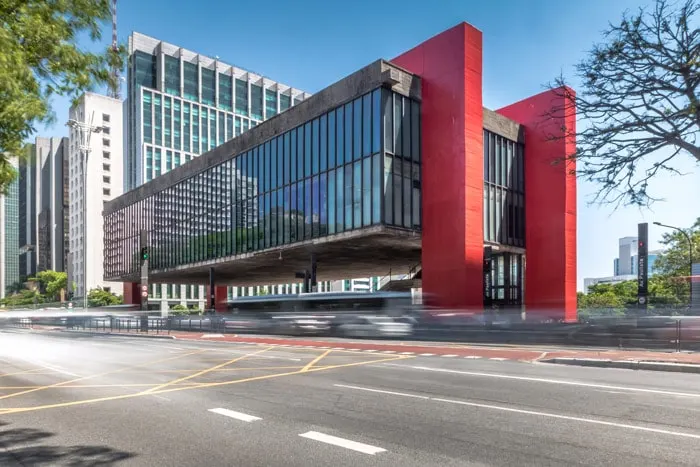
The MASP is the first museum of modern art in Brazil, opening its doors in 1947.
Housing the most important collection of European art in the southern hemisphere, the São Paulo Museum of Art has more than 11,000 artworks in its collection.
More importantly, the museum has a peculiar architecture. Made of glass and concrete, the suspended building ensures people have a view over the city center while standing underneath it.
Nowadays, the museum is a reference not only in Brazil but in the world.
Underneath the museum, festivals take place as well as a Sunday antique fair. It’s a great place to find souvenirs.
Sugarloaf Mountain
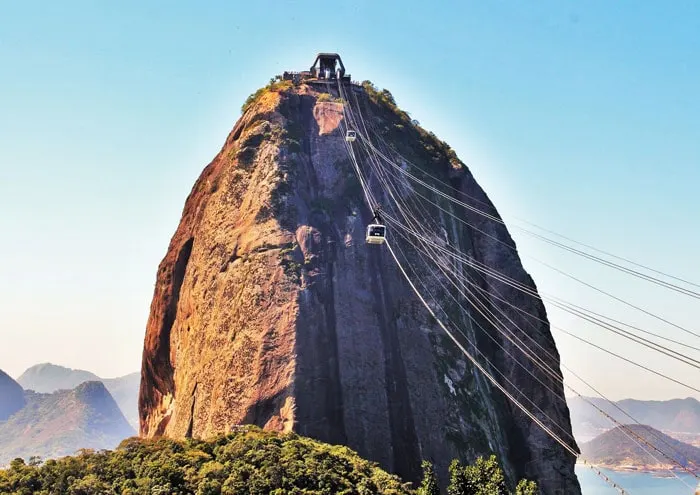
Together with other landmarks in the city, the Sugarloaf Mountain helps to compose the exceptional urban setting that got Rio de Janeiro listed as a UNESCO World Heritage Site.
After taking the cable cars, take in the views at 1,299ft (396m) above the sea level. I can assure you this is one of the prettiest sights you’ll ever see in your life.
Atop the mountain, you’ll also find a theater, shops, small cafes, and small exhibitions about the Sugarloaf and cable cars.
You will want to visit it early in the morning on weekdays to avoid long lines.
The first time I visited it was in the afternoon, and we waited in line for hours. Approximately 3,000 people ascend the mountain every day on high-season, that is December, January, and February.
However, the second time I went there, we didn’t have to wait at all because we arrived at opening hours. You’re welcome.
Iguazu Falls
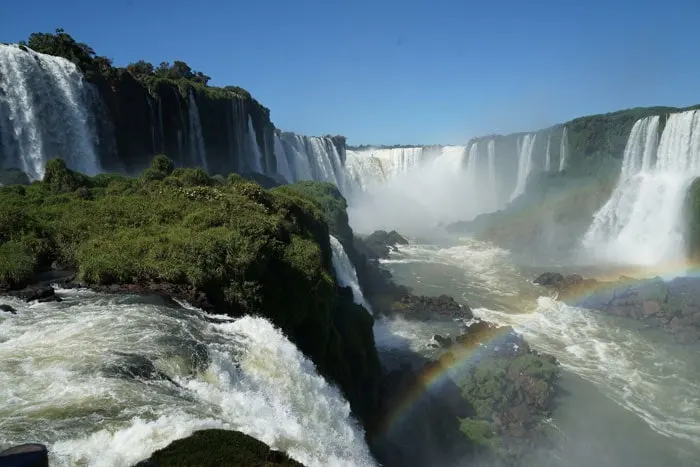
Iguazu Falls need no introduction.
Often among the top items of any Brazil bucket list, let alone South America, these waterfalls on the Argentinean-Brazilian border are majestic.
But what is so special about the Iguazu Falls? Well, the Iguazu has a whopping 275 falls, which makes it the world’s most extensive waterfall system.
Its name comes from Tupi-Guarani, the language of one of the first Indigenous people in Brazil, and it means big water (y=water + ûasú=big).
Among so many beautiful falls, the most scenic one is the curved cataract called the “devil’s throat.” This part has 14 falls dropping from a height of 350 feet.
The deafening sound of 450,000 cubic feet flowing (rainy season) per second is mesmerizing.
That, together with the realization of how small you’re next to one of the most imposing landmarks in Brazil, makes you have greater respect for nature.
If the Iguazu isn’t one of the most majestic Brazilian landmarks, I don’t know what it is then.
Granted, we share it with Argentina, but the view from the Brazilian side is impressive nevertheless.
Brazil landmarks facts
- First Lady Eleanor Roosevelt said, “Poor Niagara,” upon seeing the Iguazu Waterfalls.
- Every year, one of the most famous Brazilian landmarks, Christ the Redeemer, receives nearly 2 million visitors. The record number of visitors to the statue in a single day was a whooping 14,000 during the Easter of 2011.
- The Iguazu Falls are the most visited natural landmarks in Brazil.
- Elizabeth II was the one who inaugurated the MASP in 1968.
- The city of São Paulo, although massive, fits inside the Lençóis Maranhenses National Park.
Landmarks in Brazil FAQ
What is the most famous landmark in Brazil?
By far, the most famous Brazil landmark is Christ The Redeemer Statue.
What is the most famous building in Brazil?
Brazil’s most famous building is Copan, a 459ft (118m) tall, 38-story residential building in São Paulo.
Designed by Oscar Niemeyer, the undulating construction is one of the most extensive buildings in Brazil.
What are Brazil’s monuments?
Some of the most significant monuments in the country are the Arcos da Lapa in Rio de Janeiro, Montserrat Fort in Salvador, and the Obelisk in São Paulo.
What is Brazil famous for?
Among many things, Brazil is mostly famous for having:
- Great soccer teams.
- People who are passionate about the carnival. (One of the reasons people visit Brazil.)
- Delicious food.
- Excellent coffee.
- Multicultural people.
- Lively and warm culture.
Final words on Brazilian landmarks
While there are many famous places in Brazil, most international visitors don’t know a bunch of things about the country.
And when they finally decide to visit Brazil, they usually don’t know where to start planning their trip.
I see this a lot among my readers. Most of them can name up to five monuments and landmarks to visit in Brazil, and that’s all.
But that’s not their fault. Not at all.
Most bloggers out there only visit the same cities and talk about the same old places.
That’s why I decided to show you some popular landmarks in Brazil, but also some off the beaten path ones.
This way, you can plan your trip a little bit better. For more information about our customs and traditions, read this article on Brazilian Culture. If you want to know new places in Brazil, check out my destinations page.
Oh, and don’t forget that I have a whole category about useful travel guides here on the blog.
I hope you enjoyed this list of landmarks in Brazil.


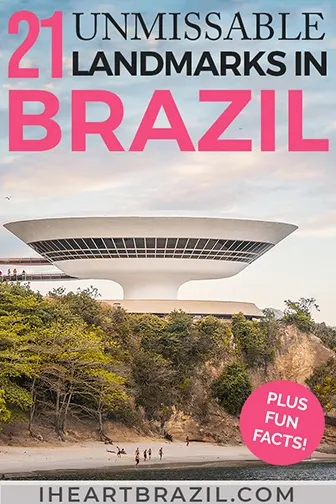
Asher Spencer
Friday 14th of January 2022
I love Brazil 🇧🇷 it's landmarks are so amazing especially the sugarloaf mountain and the Iguaza Falls I loved this article because it gave me so many more places to visit the next time I go to Brazil. So thank you for the wonderful places to visit in my next trip.
Edmir
Wednesday 28th of April 2021
I had to stop by and say that I loved this article. It really explores beautiful places in Brazil. I'm sharing it. Congrats!
Bruna
Wednesday 28th of April 2021
Hi Edmir, thank you so much for your comment. I appreciate you sharing the article. Have a lovely day!